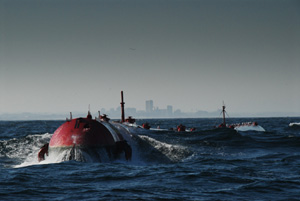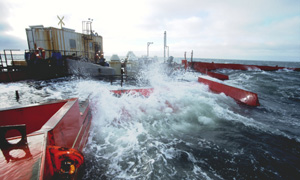Oceans of …
on
Oceans of …
The BP oil spill in the Gulf of Mexico drew some interesting responses from the European Commissioner of Energy, Günther Oettinger and the Commissioner of Maritime Affairs and Fisheries, Maria Damanaki. In a speech to the European Parliament on 7 July, Oettinger referred to ‘the maritime aspects of the challenges we’re facing, notaby how we can turn the terrible accident in the Gulf of Mexico into an opportunity for literally “untapped waters” so far, such as the potential for renewable ocean energy’. Renewable ocean energy – as an alternative to deepwater oil? Was the Commissioner serious?
 |
| Pelamis Sea Snake off the Portuguese coast |
Apparently, the European Commission is highly optimistic about the possibilities of “renewable ocean energy”, so much so that it feels it could serve as a realistic alternative to deepsea oil and gas production. On what is this optimism based? It is possible of course that Oettinger and Damanaki have been reading a recent publication of the European Ocean Energy Association (EOEA): ‘Oceans of energy – the European Ocean Energy Roadmap 2010-2050’. According to the EOEA’s website, this “roadmap” was first published on 5 May of this year at a dinner debate hosted by the Danish Social-Democratic MEP Britta Thomsen. It was later re-issued with a press release on 15 July. It is, as you may expect from a report issued by an “ocean energy association”, rather upbeat about the prospects of ocean energy. In fact, the report claims that ocean energy (that is, energy from waves, tides, currents, temperature gradients and salinity gradients) could meet no less than 15% of ‘EU energy demand’ by 2050. If that is true, it would be reason for some enthusiasm of course.
Later in the report, the claim is somewhat amended, as it turns out that what the EOEA is really talking about is 15% of electricity consumption in Europe. Doesn’t the EOEA know the difference between energy and electricity? The false “energy” claim was repeated in a story by the online publication Euractiv on 20 July, which uncritically cited the EOEA’s press release.
Water wheels
This challenge, however, is essentially good news, according to the EOEA, because we should see it as an opportunity for job creation. Indeed, 188 GW of ocean energy capacity, says the roadmap, will lead to the creation of 471,320 new ‘sustainable jobs’. Of course, jobs is the way to sell any project in Brussels or elsewhere nowadays, and who can beat 471,320 new ones? The roadmap even presents graphics for both wave energy and tidal energy displaying the ‘number of jobs per MW of ocean energy installed capacity’.
 |
| The Wave Dragon in Welsh offshore waters |
The roadmap does refer to a source for this figure, namely the FREDS Marine Energy Group Roadmap 2009. However, this report, published by the Forum for Renewable Energy Development in Scotland (FREDS), does not give any cost estimates at all, apart from some figures for very small-scale ocean energy projects. Thus, the €451,104 billion mentioned in the EOEA roadmap remains a mystery.
Propaganda
Now my point is not that there is necessarily anything wrong with ocean energy. For all I know, it may be the greatest advance in energy technology since the discovery of the solar cell. For one thing it is no doubt true that, as proponents of ocean energy claim, theoretically the world’s oceans harbour huge amounts of energy, enough to meet the world’s entire energy needs. And some serious companies are indeed taking a serious look at the possibilities offered by ocean energy. According to a presentation held at an EOEA seminar on 6 and 7 May of this year, Swedish utility Vattenfall has ambitions to produce 30 TWh of marine energy in 2030. This amounts to no less than 20% of Sweden’s current total electricity production. Vattenfall estimates that meeting this target would require an investment of some €15 to €20 billion, excluding operation and maintenance costs of some €500 million annually. The company assumes that from 2020 on, production costs of marine energy will be down to €0.15-0.20 per kWh.
Whether this is feasible is another story. RWE npower, another company that is testing the waters of ocean energy, mentioned a number of “challenges” at the same seminar. It said that the technology ‘has a fair way to go’, the ‘useable resource is not well-understood’, the current ‘support mechanisms’ are ‘inadequate’ and the true commercial costs are simply ‘not yet known’. On a positive note, RWE said that ‘some marine technologies are ready for commercial demonstration’. The company concluded that what is needed is ‘to build some projects to learn by doing’. This seems a much more realistic assessment of the state of affairs of ocean energy.
Please don’t misunderstand me. I am not saying there is anyhing wrong with companies and people pursuing new forms of “sustainable” energy generation, especially not if they are backed by private investors. But to hear European Commissioners touting uncertain, embryonic technologies as realistic alternatives to our current energy production system, based on unsubstantiated propaganda from lobbying groups, is, frankly, unsettling. It seems hardly the way to inspire confidence in the market or among the public at large about the future of our energy system.


Discussion (0 comments)